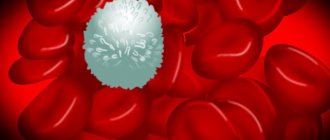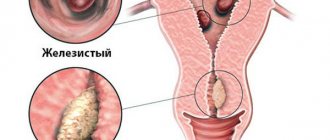The disease is quite rare. The complexity of treatment is due to the fact that the simplest section besides medication is replacement transfusion therapy of red blood cells and/or platelets. For complex cases, the only option left is a bone marrow transplant - an expensive operation with a number of complications.
According to statistics, the risk zone for aplastic anemia is young people under 20 years of age (the viral nature of the pathology predominates), as well as people over 65 years of age (accumulated age-related disruptions of biochemical processes as the cause).
Attention. The disease has a high mortality rate - more than 80%.
Statistics can be seen in the video at the end of the article.
Hematopoiesis
Before characterizing a disorder of the hematopoietic system, it is worth understanding how cells mature.
The bone marrow is the only hematopoietic organ in the body. It is located in spongy bones and epiphyses of tubular bones. Proliferation (increase) in the number of cells occurs through mitosis, that is, cell division with an even distribution of genetic material.
Cell maturation occurs between divisions. Various substances help them in this: hematopoietic growth factors, interferons, lymphokines, chemokines and others. They additionally activate and regulate immune responses. Several hematopoietic sprouts are distinguished.
There are several stages for a stem cell to develop into a mature blood cell. As can be seen from Scheme 1, a cell gives rise to others, which in turn are the predecessors of others, and so on. Blast cells make it possible to morphologically recognize which path the differentiation process takes. As cells reach functional maturity, they lose their ability to divide.
The final stage of hematopoiesis is the release of mature functionally active cells into the bloodstream.
Classification of the disease
Aplastic anemia is divided into acquired and hereditary forms. This type is represented by the following cases:
- acute type - the disease occurs suddenly and progresses rapidly;
- subacute anemia - development continues for 1–6 months, proceeds smoothly;
- chronic type - lasts more than six months, the disease gradually progresses.
Congenital aplastic anemia is represented by the following types:
- Fanconi anemia is a pathology characterized by the presence of congenital anomalies in the development of internal organs and inhibition of hematopoietic function;
- Estren-Dameshek anemia - is represented by damage to the hematopoietic function, but there are no abnormal changes in the internal organs.
There is another form - Diamond-Blackfan syndrome (partial red cell anemia), in which the production of red blood cells decreases.
According to the ICD-10 classification of diseases, the disease in question belongs to the group of other anemias with code D61. The following clarifications are allowed:
- D0 - constitutional form, this also includes other hereditary types;
- D1 - medicinal form (a drug code is additionally assigned if there is a need to identify it);
- D2 - form caused by external causes;
- D3 - idiopathic type, in which the causes of anemia are unknown;
- D8 - other anemia with specified factors;
- D9 - anemia has an unspecified form.
Prevalence of aplastic anemia
On average, 2–3 cases per year occur per 1 million population. There is a dependence on the area - the figure is 2 times higher in the Far East. Race doesn't matter. There are 2 peaks of occurrence: in young people (14 – 25 years old) and elderly people (60 years old). It occurs equally in men and women.
Treatment methods
Treatment of aplastic anemia is a complex and complex process that requires the active participation of the doctor and the patient. The following groups of drugs can be used for drug therapy:
- Antibiotics (Amikacin, Ceftriaxone, Tobramycin). Prescribed when a bacterial infection occurs.
- Cytostatics (Imuran, Methotrexate, Cyclophosphamide). Prescribed for the treatment of acquired forms of aplastic anemia.
- Immunosuppressants (Methylprednisolone, Dexamethasone). Reduce the immune response by allowing the bone marrow to produce blood cells.
- Hematopoietic stimulants (Neupogen, Leukin). Strengthens the production of blood cells by the bone marrow.
The only radical way to control aplastic anemia and get a positive result is bone marrow transplantation. This technique is most effective at a young age, but there is one difficulty - the material for transplantation must be compatible or partially compatible with the antigenic composition of the patient’s bone marrow. In this case, the patient's next of kin is best suited.
Before transplantation, chemotherapy is used, aimed at suppressing the protective properties of the patient's body. This measure is related to the need to prevent rejection of the transplanted cells.
Blood transfusions can be used to treat pathologies associated with low red blood cell or platelet counts. The technique does not cure aplastic anemia, but the disease will be brought under the control of specialists, which will have a positive effect on the patient’s well-being.
How blood transfusions are performed for children is written here:
Gallery of medicines
Ceftriaxone is used to eliminate infection Imuran is a drug from the group of cytostatics Methotrexate can be used to treat aplastic anemia due to its properties Neupogen helps the bone marrow produce blood cells Methylprednisolone reduces the response of the immune system
Causes
When the reasons that caused the development of the disease are unknown, it is called idiopathic. This happens in most cases. But sometimes it is still possible to establish the cause. She may be:
- the effect of ionizing radiation;
- toxins – benzene, insecticides;
- medications – chloramphenicol, non-steroidal anti-inflammatory drugs, cytostatics;
- hepatitis, Ebstein-Barr viruses;
- diseases of the immune system;
- genetic disorders during the maturation of bone marrow cells.
Some sources indicate that aplastic anemia may develop during pregnancy.
Possible complications
Without treatment, the risk of death is 80%. The most common causes are resulting leukemia, myelodysplastic syndrome, and sepsis. It is also highly likely that the patient will die from the development of fungal and bacterial infections.
With timely treatment, the prognosis is favorable, especially for mild forms of the disease. Bone marrow transplantation allows achieving remission in 80 - 90% of cases. In the autoimmune form, removal of the spleen helps restore blood cell counts in 80% of cases.
Mechanism of development of the pathological process
The presence of a defect in stem cells or a decrease in the number leads to their low proliferative activity. Another mechanism for the development of aplastic anemia is a violation of the regulation by immunocompetent cells of the processes of maturation of blood sprouts (hematopoiesis). Pathology of the microenvironment is one of the possible ways leading to inhibition of blood cell synthesis or their complete absence.
A combination of several mechanisms in the development of aplastic anemia is possible.
Reasons for development
Many people are interested in the question, what is aplastic anemia and why does it appear? Unfortunately, modern medicine cannot name the obvious reasons for the development of aplastic anemia in humans. But it is known that the disease can be acquired and hereditary.
There is a theory that the development of pathology is associated with the peculiarities of the functioning of the body of each individual. However, there are some factors that can trigger the onset of the disease. In particular, the clearest factor is human exposure to ionizing radiation, which suppresses the functions of the bone marrow and leads to a decrease in its production of red blood cells, platelets and white blood cells. Predisposing factors also include the following:
- poor environmental situation in the region;
- regular human contact with harmful chemicals;
- some infectious pathologies, in particular hepatitis, cytomegalovirus infection;
- bone marrow problems;
- taking certain medications, including common antipyretics and pain relievers such as aspirin;
- frequent use of antibiotics, especially chloramphenicol.
It has been found that the disease is observed in patients with excessive cravings for alcohol. Genetic predisposition also plays an important role in the development of the disease. Aplastic anemia in children often develops as a result of hereditary pathologies, including Fanconi anemia. It should be noted that children are often diagnosed with idiopathic aplastic anemia - that is, a pathology with an unclear etiology.
As for such a pathology as hypoplastic aplastic anemia, this is an even more severe pathology that causes serious disruptions in the functioning of all internal organs and leads to disruption of the functioning of body systems.
It should also be said that aplastic anemia comes in three forms of severity:
- very severe (platelets less than 20.0x109/l; granulocytes less than 0.2x109/l)
- severe (platelets less than 20.0x109/l; granulocytes less than 0.5x109/l), according to trepanobiopsy - low bone marrow cellularity (less than 30% of normal)
- moderate (platelets more than 20.0x109/l; granulocytes more than 0.5x109/l)
Aplastic anemia, occurring with selective inhibition of erythropoiesis, is called partial red cell aplasia.
Clinical manifestations of aplastic anemia
All the main symptoms of aplastic anemia occur due to a deficiency of blood cells and impaired function. A deficiency of platelets leads to the development of hemorrhagic syndrome, leukocytes (agranulocytosis) - reduced immunity, erythrocytes - anemic syndrome.
As noted earlier, acute and chronic course of aplastic anemia is possible. In 15% of patients, the disease is acute and is accompanied by elevated body temperature and multiple hemorrhages. In the congenital form (Fanconi anemia), growth and development delays and “coffee” spots on the skin are possible.
Anemic syndrome is manifested by dizziness, flashing “spots” before the eyes, and weakness.
Leukocytopenia - a low level of white blood cells is accompanied by the addition of a bacterial infection.
Hemorrhagic syndrome - manifested by bleeding (nose, gum, uterine), rashes on the skin. With hemorrhage in the fundus of the eye, this may manifest itself as a decrease in visual acuity. Most often this is typical for young people with severe aplastic anemia.
Symptoms
Fatigue and weakness are nonspecific signs of anemia
Aplastic anemia often manifests itself sharply, but in some cases the disease develops unnoticed, and the person only experiences increased fatigue and lethargy. Gradually, all the characteristic signs of pathology begin to be felt. Since the production of all hematopoietic cells is inhibited, the patient experiences symptoms that indicate their deficiency in the blood.
Lack of red blood cells:
- pale skin,
- feeling of constant fatigue,
- dyspnea,
- brittle hair and nails,
- cardiopalmus,
- immunosuppression.
Lack of leukocytes:
- temperature increase,
- chills,
- headache,
- stomatitis,
- the appearance of ulcers in the mouth.
Lack of platelets:
- bleeding from the nose, gums,
- subcutaneous hemorrhages, bruises,
- bruising with minor impact.
Diagnostics
The diagnosis is confirmed on the basis of clinical symptoms, laboratory and instrumental research methods. The characteristic symptoms of aplastic anemia are listed above.
The first laboratory test is a general blood test, which reflects the level of all formed elements. As has been mentioned more than once, there will be pancytopenia - low levels of blood cells.
Detected anemia is characterized by a color indicator. In aplastic anemia, it is normochromic or may have slight hyperchromicity. Reticulocytes are reduced or absent. ESR (erythrocyte sedimentation rate) readings will be increased. A low level of leukocytes occurs due to a deficiency of granulocytes, and relative lymphocytosis is noted. The structure of platelets and their functional abilities are disrupted.
A bone marrow puncture is performed. The characteristics of the resulting punctate will depend on whether the needle entered the depressed lesion or the remnants of normally functioning bone marrow. In the first case, the punctate will be depleted of cellular elements, the number of young forms of granulocytes will be reduced, the percentage of lymphocytes will be increased, and the processes of differentiation and proliferation will also be disrupted.
The detection of blast cells in punctate is not related to aplastic anemia, which means that one should look for another pathological process similar to this in clinical manifestations and disorders of the maturation of hematopoietic cells.
There is deposition of excess iron in the form of pigment in the liver, spleen, and bone marrow. For a correct diagnosis, it is necessary to find out what could lead to a reduced level of leukocytes (toxic substances, medications, infectious agents, autoimmune lesions, chronic inflammatory processes, hypothyroidism).
Anemia similar to aplastic anemia can occur with partial red cell aplasia. In this condition, the processes of synthesis and differentiation of erythroid cells are disrupted in isolation, and the production of antibodies to bone marrow cells is possible.
The diagnosis of aplastic anemia is made if any 2 of the following criteria are present:
- hemoglobin level less than 100 g/l;
- leukocyte level less than 3.5 * 109 / l (granulocyte content less than 1.5 * 109 / l);
- hypocellular bone marrow and platelet level less than 50 * 109/L.
Characteristics of the severity of aplastic anemia are presented in Table 1.
Table 1. Criteria for the severity of aplastic anemia.
| Severity | Criteria |
| Moderate |
|
| Heavy |
|
| Very heavy |
|
Determining the severity of aplastic anemia is important when prescribing therapy and the timing of its implementation.
Classification
Typing is carried out according to the severity of aplastic anemia. According to this criterion, three main forms of the disease are distinguished.
- Easy. Accompanied by minimal changes in cell synthesis. Excessive production of certain chemicals occurs. However, at this stage the person does not yet notice symptoms.
In rare cases, small ulcers and red spots may form on the skin. In addition, nosebleeds occur. Basic anemic symptoms are detected: headache, weakness, nausea, others, including decreased performance. This is the ideal time to start treatment.
- Average degree. Gives an already pronounced clinic, which is difficult not to notice. Complete hemorrhagic and anemic manifestations are present. The quality of life is seriously reduced. Lethal risks are noted, but so far relatively low. Thrombocyte and granulocyte indices are within a moderate decrease.
- Severe degree. The clinic is full, there are real risks of death. This is the extreme phase, it is also terminal. Massive disturbances in the functioning of the body are observed, and critical complications lead to the death of the patient. Even complete treatment measures do not always have an effect.
The second way of classification is by the nature of the disease.
Highlight:
- Congenital form. Genetic defects are often found to be the direct culprit of the disorder. In children and young people under 25 years of age, the manifestation of the diagnosis is observed most often. The second peak occurs after 50, but much less frequently.
- Acquired form of aplastic anemia. Occurs in almost 80% of cases. Becomes the result of diseases. Including cancer, endocrine disorders and other possible ones.
Classification is used according to aggressiveness and nature of the course:
- Acute form. Accompanied by a sharp drop in the number of formed blood cells, a pronounced clinical picture. This type of process is the most common. They talk about it if the symptomatic complex is observed for up to 1 month.
- Subacute form. From 30 days to six months. Accompanied by a relatively sluggish clinical picture. However, this does not make the danger any less.
- Chronic type. Duration over 6 months.
Finally, the disease can be classified by origin and etiology.
Accordingly they are called:
- Primary disorder. Caused by genetic defects. Present with a person, either openly or hidden, from birth.
- Secondary form. Occurs as a result of other abnormalities suffered.
It is not always possible for a doctor to immediately and even after a thorough diagnosis discover the causes of the pathological process; in such a situation they speak of idiopathic aplastic anemia.
With further examination, the diagnosis may be revised. Depending on the diagnostic results.
Treatment of aplastic anemia
The main treatment method for aplastic anemia is to restore the number of hematopoietic cells, as well as prescribe immunosuppressive therapy to suppress immune reactions. The most effective method is hematopoietic stem cell transplantation.
During bone marrow transplantation, donor and recipient compatibility must be carefully assessed to avoid graft-versus-host disease.
It is noted that for aplastic anemia caused by chemotherapy and congenital forms, immunosuppressive therapy is not effective.
Immunosuppressive therapy includes:
- antilymphocyte immunoglobulin;
- cyclosporine;
- glucocorticoids;
- cytostatics.
Please note that you should not self-medicate, since each medicine has its own indications, contraindications, and side effects.
It is not allowed to use immunosuppressive drugs in the presence of an infectious-inflammatory process, severe disorders of the cardiovascular system, liver, kidneys, or intractable hemorrhagic syndrome.
With any therapy, patient monitoring by medical personnel is necessary to assess possible allergic reactions that may occur to the components of the drug. There may be a delayed allergic reaction that appears after 2 to 3 days.
The use of growth factors ensures the maintenance of granulocytes at a level of 1 – 1.5 * 109/l. Lymphocytoplasmapheresis may be prescribed as an additional treatment method. It is justified in the presence of an allergic reaction or the formation of antibodies to blood cells. Another direction of treatment for aplastic anemia is therapy against the main complications: infectious, hemorrhagic, allergic. In some cases, platelet and red blood cell transfusions are performed.
Table 2. Indications for prescribing transfusion of red blood cells and platelet concentrate.
| Blood components for blood transfusion | Indications |
| Red blood cell mass | Hemoglobin less than 90 g/l Hematocrit less than 30% |
| Platelet mass | Bleeding due to low platelet levels (10 – 20 * 109/l) |
Clinical picture
Congenital forms
With hereditary aplastic anemia, the symptoms depend on the disease that caused the disease. Moreover, aplastic anemia in children is, in most cases, the debut of congenital forms of this disease.
Fanconi anemia is a hereditary pathology characterized by an autosomal recessive type of inheritance. The disease usually debuts between the ages of 4 and 12 years, however, hematological disorders can occur immediately after the birth of the child. With Fanconi anemia, congenital defects of the musculoskeletal system occur:
- deformation or absence of the radius bones;
- absence of the first fingers of the hands;
- headache;
- fast fatiguability;
- tendency to hemorrhages (often these are the causes of death);
- frequent colds;
- underdevelopment of the genitourinary organ complex;
- pronounced inhibition of all types of hematopoiesis;
- When examining the bone marrow, the picture is aplastic.
Pathology usually progresses rapidly. In the absence of timely adequate treatment, severe anemia quickly develops, which can lead to death.
The cause of death in most cases is hemorrhage (gastrointestinal bleeding or cerebral hemorrhage).
For Fanconi anemia, the only effective treatment method is bone marrow transplantation from a healthy donor, which can be, for example, a close relative of the patient.
Bone marrow transplantation
Estren-Dameshek anemia is characterized only by abnormalities in the composition of the blood.
Diamond-Blackfan anemia is a disease from the category of hereditary sporadic pathologies. The debut occurs during the first year of life. With this disease the following are observed:
- isolated damage to the erythrocyte germ;
- pathological changes in bones;
- characteristic eye damage;
- the skin acquires a characteristic grayish tint;
- hepatosplenomegaly appears early;
- platelets and leukocytes are contained in the blood in normal quantities, a decrease is observed only in the case of significant damage to the spleen;
- characteristic phenotype: enlarged upper lip, widely spaced eyes, pale skin, dry hair and bone age lagging behind the passport age;
- This severe disease is fatal before reaching 20 years of age. Laboratory studies revealed a picture of normochromic anemia with normal proliferation of platelet and granulocytic lineages;
- An effective treatment tactic for this form of anemia is therapy with glucocorticosteroid hormones in combination with red blood cell transfusion for health reasons.
Treatment with hormones
Acquired forms
Depending on the predominant damage to one or another of the sprouts, it is advisable to divide all manifestations observed in aplastic anemia into the main clinical syndromes.
Anemia itself:
- dizziness of varying severity;
- physical weakness;
- noise in ears;
- breathing problems, shortness of breath;
- feeling of increased heartbeat.
Hemorrhages:
- bleeding, loose gums;
- the appearance of hematomas not caused by trauma;
- nosebleeds;
- there is a possibility of hemorrhage in the brain.
Granulocytopenia:
- decreased protective function of the body’s immune system, frequent incidence of various infections;
- purulent inflammation of soft tissues even with minor injuries;
- the occurrence of abscesses at the injection site;
- cyanosis and bruising on the skin;
- pinpoint rashes on the skin;
- characteristic murmur on auscultation of the heart;
- heart rate is increased;
- arterial hypotension;
- possible complication in the form of sepsis;
- in severe cases, hepatomegaly is detected, and scleral icterus may be noted.
Remission - laboratory criteria
To evaluate therapy, the concept of remission is used. Improvement of bone marrow hematopoiesis - incomplete (partial) remission, allows the patient to avoid dependence on blood transfusions. The number of granulocytes in the blood is more than 0.5 * 109/l, which reduces the risk of severe infectious complications. Complete remission is accompanied by the absence of clinical manifestations, the hemoglobin level returns to normal, the platelet count is more than 100 * 109/l, granulocytic leukocytes - 1 * 109/l.
Forecast for life
Remission can be achieved in approximately half of patients. The prognosis is slightly better in children than in adults.
The presence of a large amount of fat in the bone marrow does not mean the process is irreversible. There are cases when such patients experience complete remission and complete repair of bone marrow hematopoiesis. The prognosis is better when the content of reticulocytes is increased, when there is a more polymorphic picture in the bone marrow, when there is a slight increase in the size of the spleen and at least a small but clear effect of corticosteroid hormones.
In these cases, splenectomy often has a good effect until complete recovery.
In some patients, aplastic syndrome is the onset of acute leukemia. Sometimes signs of hemoblastosis are revealed only several years after the onset of the disease. Iron deficiency anemia Hemolytic anemia Hemorrhagic cerebral stroke Hydrocephalus of the brain in children Microstroke Crohn's disease
Prevention
Prevention of the development of aplastic anemia involves limiting the influence of unfavorable external factors on the body. It is necessary to follow safety rules when working with ionizing radiation, benzene, avoid uncontrolled use of medications, treat diseases of organs and systems that lead to a decrease in hematopoiesis, for example, kidney pathology, cirrhosis of the liver.
With confirmed aplastic anemia, it is necessary to monitor the patient's condition, constant monitoring of the levels of formed elements, so as not to miss a relapse and possible complications.
Causes
The development factors are multiple. Among the direct culprits are:
- Past infectious disorders. Hepatitis of various types, tuberculosis, damage by herpetic agents.
- The use of certain medications, as mentioned earlier.
- Exposure to radiation. Including long-term exposure to small non-critical doses. Nuclear power plant workers, submarine workers, and other categories are especially susceptible to this disorder.
- Congenital genetic abnormalities.
- Proven connection with pregnancy. However, experts cannot yet say whether gestation is the direct cause of the onset of abnormal changes in the body or whether it acts as a provocateur for the manifestation of the disorder.
- Diseases of the lymphatic system.
- Tumors, especially malignant ones.
Despite the effectiveness of diagnosis, the causes cannot always be detected. In approximately 50% of cases, we are talking about an idiopathic type of anemia. When it is impossible to find a provocateur. At least at the time of diagnosis and its verification.
It will take more than one week, or even months, of work in this direction, dynamic monitoring of the patient’s condition.
Signs of the disease
Clinical manifestations of aplastic anemia are very typical. The onset of the disease is usually acute. There are 3 characteristic syndromes indicating the inhibition of one or another hematopoiesis:
- anemic (is a sign of impaired formation of red blood cells; patients complain of general weakness, lethargy, drowsiness, irritability, fatigue, poor sleep and appetite, dizziness, tinnitus, shortness of breath, rapid heartbeat, pale skin);
- hemorrhagic (a sign of a reduced level of platelets in the blood; pinpoint hemorrhages (petechiae) and hematomas on the skin, frequent nose and gum bleeding, heavy periods in women, the presence of blood in the urine, prolonged bleeding even with the slightest cuts, etc.);
- leukocytopenia syndrome (a sign of a reduced content of leukocytes in the blood, in particular neutrophils; frequent infectious diseases that occur over a long period of time and with complications, chronic foci of infection on the skin, lungs and other organs, stomatitis, a seemingly causeless increase in body temperature).
By auscultation (listening) of the heart, the doctor will determine the presence of a murmur; by palpation (palpation) and percussion (tapping) of the abdomen, an enlargement of the liver and/or spleen. The disease progresses differently: in some cases it progresses quickly, leading to death in a few months or even weeks, in others it progresses for a long time, with alternating periods of exacerbations and remission.
Hypochromic anemia
Hypochromic anemia is a general name for diseases in which the number of red blood cells in the blood volume is reduced and the color index is reduced. The disease can occur for several reasons:
- Significant blood loss during surgery or childbirth, internal hemorrhages, injuries that led to bleeding, donation;
- An unbalanced diet is poor in protein and vitamins and iron;
- Digestive disorders lead to insufficient absorption of nutrients that are necessary for the formation of blood cells;
- Poisoning with lead and other heavy metals;
- Impaired iron metabolism.
Symptoms may not be noticeable, but a blood test for hemoglobin, which is necessarily prescribed when going on sick leave, will certainly show the presence or absence of a problem. If the hemoglobin level is low, the attending physician recommends an additional examination that will identify the causes of the disease and clarify the type of anemia.
Treatment of hypoplastic anemia
Treatment tactics depend on the cause of anemia
- First of all, the cause of the disease is eliminated (cessation of taking medications, interactions with toxic substances).
- For autoimmune forms, glucocorticoid drugs are prescribed. In the severe stage, the best result is achieved by removing the spleen. There is also a new method that has proven its effectiveness - complete replacement of immune cells.
- In the presence of viral infections that cause hypoplastic anemia, treatment may consist of taking antiviral drugs, antibiotics (if bacterial infection is present), and glucocorticosteroids (for complications of various types).
- In case of intoxication from interaction with toxic substances, medications are prescribed that stop the effect of the poison on the body - antidotes.
- The general purpose in the treatment of hypoplastic anemia is transfusion. If certain blood cell counts decrease, only red blood cells, platelets, and leukocytes can be transfused. The exception is autoimmune anemia.
- Taking medications that restore hematopoiesis. For example, cyanocobalamin is a drug that promotes the maturation of red blood cells and the activation of platelets.
- Bone marrow transplantation is the only effective way to resuscitate bone marrow function in extremely severe forms of the disease.
Which doctor should I contact?
If the symptoms listed in the article appear, you should consult a physician and take a general blood test. If anemia and other disorders are detected, the patient will be referred for treatment to a hematologist. Aplastic anemia is accompanied by infectious complications, so consultation with an infectious disease specialist is often necessary. Bleeding can be stopped by appropriate doctors - a gynecologist, an ENT doctor, a dentist.
Rating: (votes - 2 , average: 5.00 out of 5)
Posthemorrhagic anemia
Posthemorrhagic anemia is associated with significant blood loss due to intestinal bleeding and is one of the complications of hemorrhoids. One of the first signs is pallor of the mucous membranes, lethargy, and drowsiness. It is often possible to observe tachycardia, a disease in which the heart rate increases.
If the number of red blood cells is critically low, then the patient will certainly experience severe dizziness, decreased attention, poor memory, and inattention. Any physical activity becomes too difficult for him and causes shortness of breath, redness in the eyes and difficulty breathing.
Blood picture and severity
In peripheral blood taken from a finger, the following is found:
- decrease in red blood cells, changes in their shape and size;
- low hemoglobin level;
- decrease in the relative and absolute number of platelets and granulocytes;
- accelerated ESR;
- relative lymphocytosis;
- increase in the number of reticulocytes.
A moderately severe form of anemia is considered to be a disease with a neutrophil content of 0.2 to 0.5 x 109 per liter of blood.
Severe cases include cases with a granulocyte count of less than 0.5 x 109, platelets - less than 10 x 109, reticulocytes - up to 1%; at the same time, in the bone marrow punctate there should be more than 65% of cells that do not form blood elements, and only a few precursors of the erythrocyte germ.
The stage of the disease is called extremely severe if the neutrophil count is less than 0.2 x 109.
Yellowness of the sclera with an enlarged liver
Prognosis and prevention
Timely and correct treatment - a positive result
Hypoplastic anemia in the moderate stage responds well to treatment and has a favorable prognosis. Severe forms provoke irreversible complications, such as sepsis, leukemia and other dangerous pathologies. Bone transplantation allows complete restoration of hematopoiesis in 80 - 90% of cases.
Persons at risk of developing hypoplastic anemia should contact a hematologist and periodically undergo the necessary tests. These include:
- chemical industry workers who come into contact with toxic substances;
- patients who have recovered from the Epstein-Barr virus, parvovirus B 19, etc.;
- children with congenital diseases (Fanconi anemia, etc.), as well as their immediate relatives;
- patients who have undergone internal organ transplantation;
- patients receiving treatment with radiation exposure.
Preventive measures include taking good care of your health: avoiding self-medication with medications, avoiding overdose of medications, as well as timely consultation with a doctor if you have symptoms of anemia.
What is hypoplastic anemia?
Red bone marrow with depressed hematopoiesis
Hypoplastic anemia is a pathology in which the basic functions of the bone marrow are suppressed. The bone marrow is the most important hematopoietic organ; every second it produces the leukocytes, red blood cells and platelets necessary for the body. They are formed from stem cells and develop into full-fledged formed elements, and then penetrate into the blood.
In hypoplastic anemia, cells die during the formation process and remain in the bone marrow without having time to replenish the reserves of the circulatory system. Depleted blood is unable to deliver oxygen to the organs, self-cleanse and resist harmful bacteria. As a result, numerous disorders occur throughout the body, which can lead to irreversible consequences.
The characteristics of this disease were first described in 1888; since then, many scientific works have been devoted to hypoplastic anemia, but the pathogenic factor causing cell destruction remains not fully understood. However, statistics show that such pathologies are becoming more common. This is explained by the spread of radiation therapy, a wide variety of medications, and the development of the chemical industry, which is one of the reasons for the formation of the disease. Today, hypoplastic anemia is diagnosed in approximately 3 to 4 cases per million people.
Features of the course of pathology during pregnancy
The combination of pregnancy with hypoaplastic anemia is quite rare. If pathology occurs, the prognosis for a pregnant woman is unfavorable, since in most cases it ends in death.
Anemia that develops during pregnancy has a particularly unfavorable course. As a rule, it is detected in the second trimester, accompanied by a rapid deterioration in hematological parameters and the addition of infectious diseases. Terminating pregnancy does not stop the development of pathological processes in the body. Therapeutic measures do not bring results.
If there are adaptation mechanisms in a woman’s body to a violation of homepoiesis, it is possible to maintain pregnancy
Pregnancy, which occurs against the background of hypoplastic anemia, causes its exacerbation. In this case, urgent diagnosis of impaired hematopoiesis is necessary, followed by early termination of pregnancy and removal of the spleen.
Detection of anemia in late pregnancy requires an individual approach in matters of delivery. It can be performed either by caesarean section or by maintaining the pregnancy until spontaneous miscarriage occurs.
Cases of a favorable outcome of delivery have been described, but the child was diagnosed with iron deficiency anemia for several months.
What diseases can it be associated with?
Differential diagnosis is carried out with diseases that are accompanied by pancytopenia. In clinical practice, it is most often necessary to differentiate aplastic anemia from acute leukemia, myelodysplastic syndrome and hairy cell leukemia. The clinical picture of acute leukemia, which debuts with pancytopenia, sometimes does not differ from that of aplastic anemia. Bone marrow aspiration biopsy and trephine biopsy can verify the diagnosis of aplastic anemia. In acute leukemia, the spleen may enlarge and cytogenetic abnormalities may appear. Hairy cell leukemia may be accompanied by bone marrow aplasia, but more often by splenomegaly.
The greatest difficulties arise in differential diagnosis when there is no splenomegaly. Trephine biopsy reveals an increase in the number of reticulin fibers and replacement of myeloid tissue with amorphous eosinophilic material. The use of flow cytophotometry allows one to detect the expression of receptors.
Myelodysplastic syndrome is sometimes difficult to differentiate from aplastic anemia. The only method that allows differential diagnosis in complex cases is ultrasound. Cytogenetic abnormalities suggest myelodysplastic syndrome.
Fanconi anemia occurs in children 5-12 years old. The disease debuts with thrombocytopenia and anemia. There are two types of Fanconi anemia - the first (classic) with gross malformations of the skeleton and internal organs, and the second affects minor anomalies, hyperpigmentation of skin areas, and growth retardation.
Aplastic anemia can be complicated by a severe form of steroid-induced diabetes mellitus, arterial hypertension, and infectious complications, in particular against the background of inadequately selected therapy.
Clinical classification
Clinical classification divides all types of aplastic anemia into hereditary and acquired.
Hereditary include anemia with complete damage to hematopoiesis, which has 2 subtypes:
- Fanconi - in combination with congenital malformations;
- Estrena-Dameshek - without vices.
As well as anemia with partial or selective damage to only the erythrocyte lineage (Diamond-Blackfan).
Acquired aplastic anemia (hypoplastic) includes cases of:
- acute, subacute and chronic inhibition of general blood cell production;
- with damage to only red blood cells - partial, red cell anemia.
Causes of the disease
This pathology belongs to the category of polyetiological diseases, that is, there are many reasons, one of which can take a dominant position and provoke a disorder in the hematopoietic system in a particular patient.
Idiopathic aplastic anemia is accompanied by a violation of the production of all blood cells: platelets, leukocytes, erythrocytes, lymphocytes.
By origin, aplastic anemia can be congenital (associated with chromosomal aberrations) and acquired (developed during life).
The congenital form is:
- hereditary - when the disease is transmitted from parents, the characteristic general signs are damage to hematopoiesis, as well as anomalies in the structure of organs that are congenital (Fanconi anemia);
- Estren-Dameshek disease manifests itself with signs similar to the previous disease, but congenital developmental anomalies are not observed;
- red cell partial aplasia or Diamond-Blackfan syndrome, the main symptom of which is a decrease in red blood cells.
Exogenous (external) include:
- Chemical agents - derivatives of benzene, mercury, petroleum products.
- Physical effects of penetrating radiation.
- Medicines - anti-tuberculosis drugs (Isoniazid, PAS), Analgin, cytostatics, sulfonamides, some antibiotics (Streptomycin, Tetracycline, Levomycetin).
- Infection - in some cases, a connection with past infectious diseases (influenza, sore throat, mononucleosis) has been proven; hepatitis C, herpes, Epstein-Barr, and cytomegalovirus viruses have a suppressive effect on blood cells.
Internal reasons include:
- endocrine disorders - a connection has been identified with decreased thyroid function, cystic changes in the ovaries in women;
- immune changes - due to the loss of the regulatory role of the thymus (thymus gland) in old age.
Some harmful agents directly affect the bone marrow (ionizing radiation, chemicals and drugs). Others act indirectly through autoimmune mechanisms (viral hepatitis B).
Diagnostic indicators
To confirm the diagnosis of “hypoplastic anemia,” the patient must undergo many studies that can confirm the presence of a disorder in the hematopoietic process. A distinctive feature of this type of anemia is that the spleen and lymph nodes do not enlarge.
Severe hemorrhagic syndrome is accompanied by the development of hypochromic anemia
Laboratory and instrumental diagnostics determine the following changes:
- Clinical blood test (reduced level of red cells, hemoglobin, leukocytopenia).
- Blood biochemistry (increased concentration of serum iron, increased saturation of iron with transferrin).
- Myelogram (reduction of cellular elements of erythrocytes, granulocytes, dysplasia of homepoiesis sprouts).











